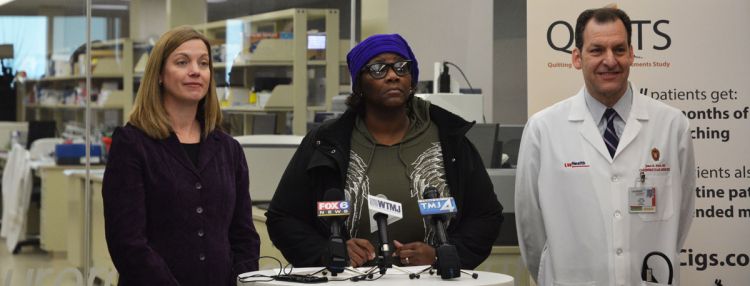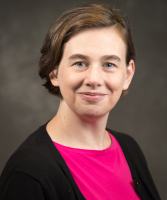Two grants totaling $10 million awarded to help Wisconsin patients quit smoking





Photo caption: UW-CTRI Associate Director Dr. Megan Piper (left), former smoker Inda Lampkins (center) and QUITS Principal Investigator Dr. Jim Stein discuss a new $7 M grant to help people quit smoking during a January 2 news conference in Milwaukee. Watch a video about Lampkins and the study.
The University of Wisconsin Center for Tobacco Research and Intervention (UW-CTRI) has been awarded two major grants totaling more than $10 M to help people quit smoking.
Quitting Using Intensive Treatments Study (QUITS)
The first study, known as the Quitting Using Intensive Treatments Study (QUITS), began recruiting subjects on January 2, 2018 in the Madison and Milwaukee areas. UW-CTRI is partnering with members of the Division of Cardiovascular Medicine on the study. UW-CTRI Director of Research Tim Baker, PhD (pictured at upper right) and UW Health Preventive Cardiology Director James Stein, MD (pictured second from top at right), Robert Turell Professor of Cardiovascular Research, are serving as principal investigators. Participants will get free medication and coaching, thanks to a $7 M four-year grant from the National Heart, Lung, and Blood (NHLBI) Institute to UW-CTRI and the UW Department of Medicine.
The study is designed to answer two key questions: 1) whether adding the nicotine patch to varenicline (Chantix) can boost quit rates; and 2) whether extending varenicline or varenicline + nicotine patch treatment for six months (rather than the standard three months) can boost quit rates. All participants will receive coaching to quit smoking.
“We expect both treatment enhancements (either adding the nicotine patch or extending treatment for six months) will yield higher cessation rates among people trying to quit,” said Michael Fiore, MD, MPH, MBA (pictured third from top at right), director, UW-CTRI. “Smokers and their clinicians are calling for cessation treatment options that can substantially increase our current modest quit rates. We believe the proposed enhancements will do just that.”
Quit Line Study on Tobacco Disparities
Overall smoking prevalence has fallen over the past five decades, but socioeconomic disparities in tobacco use and its burden have grown substantially. Prevention and treatment advances have disproportionately benefited more advantaged smokers. A project newly funded by the National Cancer Institute (NCI) will evaluate promising strategies to enhance quit-smoking success among low-income smokers.
The project will enroll 1,408 Medicaid-eligible or uninsured smokers who have recently enrolled in the Wisconsin Tobacco Quit Line, but who report continued smoking four months after engaging in standard Quit Line services. These smokers will be invited to participate in an experiment that will evaluate the value of augmenting standard Quit Line treatment with more intensive counseling, more intensive nicotine replacement, NCI’s SmokefreeTXT text support program, and/or financial incentives for using Quit Line and SmokefreeTXT support.
Analyses will examine the main and interactive effects of these four treatment components at 26 weeks, as well as other quit-smoking outcomes in this at-risk population. UW-CTRI Associate Director of Research Danielle McCarthy, PhD (pictured at lower right), associate professor, General Internal Medicine and UW-CTRI Director Dr. Michael Fiore will serve as principal investigators.
Cigarette smoking remains the chief preventable cause of disease and death in the United States, killing approximately 500,000 Americans per year. UW-CTRI has helped more than 250,000 smokers during its 25-year history.
Following the QUITS news conferences in Milwaukee and Madison in early January, a total of 2,226 Wisconsinites volunteered to participate. That’s a record response to a new study at the Center.
UW-CTRI staff are now contacting volunteers as well as holding orientation sessions and initial visits.
Resources:
- "UW Receives $7 Million Grant to Test New Medication Combination to Help Smokers Quit," UW Center for Tobacco Research and Intervention, January 2, 2018
- "More Than 2,200 Volunteer for QUITS," UW Center for Tobacco Research and Intervention, February 7, 2018
- "UW wins $7 million grant to study ways to improve the odds of quitting smoking," Milwaukee Journal Sentinel, January 2, 2018
- "UW study combines pill, patch to help smokers quit," Wisconsin State Journal, January 3, 2018